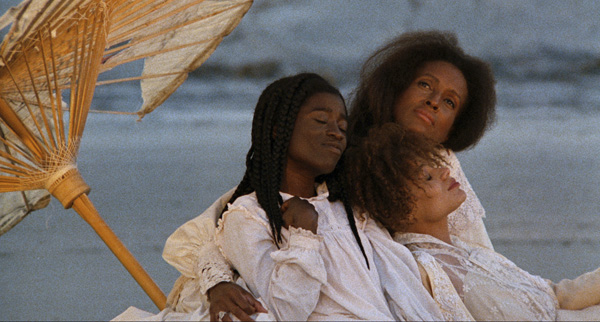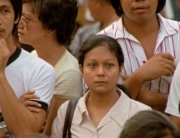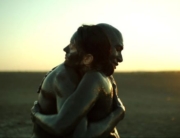
From left, Alva Rogers, Trula Hoosier (center), and Barbara-O in Daughters of the Dust (Cohen Media Group)
Julie Dash’s layered, poetic Daughters of the Dust garnered lavish praise when it came out in 1991. Now rereleased on its 25th anniversary, Daughters should kick up some dust again with its incantatory evocation of a 1902 African American family on one of the remote barrier Sea Islands. It looks back at life as members prepare to head to the mainland and join the Great Migration north. Although the movie’s style evokes an old daguerreotype, themes of identity, reflection, and change make the story timeless.
From its opening frame, the film catches the eye and holds it. Four travelers in 1890s-dress sit in a skiff stealthily guided by servants, with the sound of the oars plashing over the dialogue. Two women draped in white, one veiled, present a vision of elegance: a haughty, restless beauty named Yellow Mary (Barbara-O) has returned to reconnect with her mother and island life, and the lovely young woman (Trula Hoosier) beside her stays silent but devoted—her role a mystery. A doughty missionary (Cheryl Lynn Bruce) lit out from the island for civilization and now returns to supervise her family’s exodus, and a bemused photographer (Tommy Hicks) comes along to document the experience. These four are about to enter a contained world with its own laws and history.
Upon the crew’s alighting on the island, we inhabit different points of view, let different voices and dialects enter our heads, and wander around beaches, marshes, and rustic homes. Weather-beaten, expressive faces establish a sense of period. Nana (Cora Lee Day), the clan matriarch, muses on her life in mesmerizing Gullah patois, then offers advice to her son-in-law, Eli (Adisa Anderson), about his troubled marriage, along with a stern lecture on the family’s history. Children in white tunics play, chant, and run free on windswept beaches. The family is close to nature and all its abundance, feasting on a picnic of crabs, corn, okra, and organic eggs more than a century before today’s foodie obsession.
Slavery, the Civil War, and racism shadow the community’s story. On a smaller scale, rifts, separation, and mistrust do, too. Arguments break out over whether to decamp the island or cling to familiar ways. In a movie alive with strong women, two face off, religious self-righteousness battling baleful resentment. (As the photographer, Hicks counters the roiling female energy with affable, relaxed masculinity.) Yellow Mary seems embroiled in conflicts one minute, detached and sauntering off with her companion the next. Like any family, this group has its grudges and its feuds. Some will play out, some will not, and for some we never really know the outcome.
Deep traces of Africa are imprinted through dance, song, and ritual. So are wisdom and tragedy. And so are less welcome touches of the early 1990s, such as jerky stop-motion sequences and John Barnes’s omnipresent score, sometimes soulful and thrilling, other times ripe with the spirit of another bygone John—John Tesh. The film can also be a little more static and declamatory than one might prefer. But for its languid pace and occasionally dated feel, Daughters of the Dust brings surprises with its final roundup of who stays and who goes. It even introduces an unexpected narrator who will emphasize the cycle of life and rebirth in the family. Change comes to the island, but along with the tides, we still retain a sense of eternity. In these times, that’s comfort to the soul.
















Leave A Comment